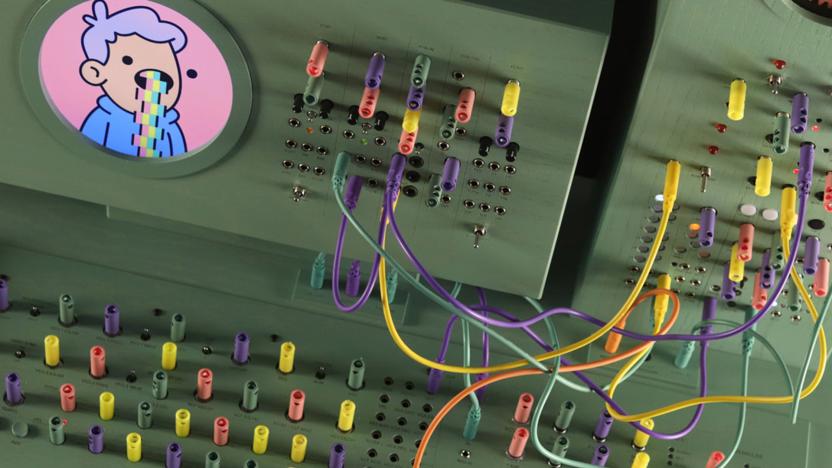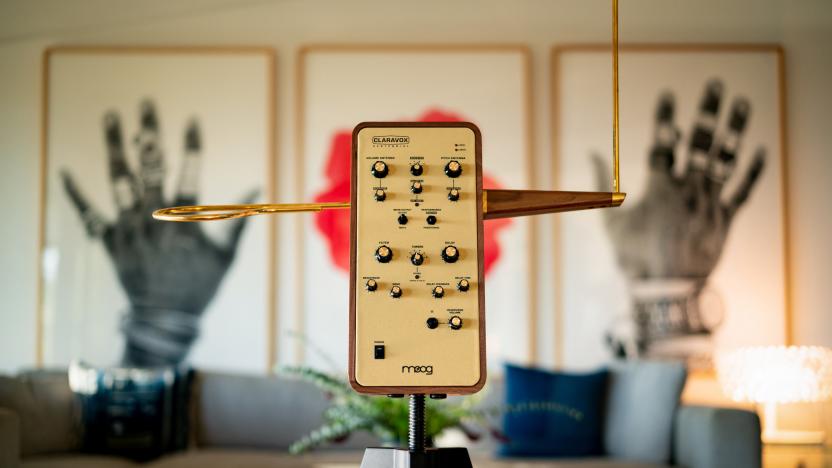theremin
Latest

Love Hulten’s latest synth project has a rainbow puke MIDI visualizer
Love Hulten has unveiled a synth machine that represents sound with rainbow puke — and there's a theremin for good measure.

Moog's Etherwave Theremin makes a classic design more convenient
Improved portability and bass response headline Moog's "if it ain't broke" approach.

Moog celebrates 100 years of Theremin with the Claravox Centennial
It was way back in 1920 that Lev Sergeyevich Termen, better known as Leon Theremin in the west, first demonstrated one of the most important electronic musical instruments ever. The instrument is very much ingrained in the DNA of Moog.

Moog museum tells the history of popular synthesized music
There's no doubt that Bob Moog had a massive influence on music by making synthesizers popular and accessible, and now there's a dedicated place to pay homage to his legacy. The Bob Moog Foundation has opened the Moogseum, a museum in Asheville, North Carolina that includes static and interactive exhibits devoted to its namesake's synths as well as other electronic instruments.

A collection of man-made 'music' and the machines behind it
As technology became a part of modern life in the 19th century, an increasing amount of scientific study led to breakthroughs in electronic sound engineering -- often as a byproduct of other research. Humans became enamored with the crystalline clarity of these exotic machine-borne tones and as the technology matured, so did the range of output. Electrically powered machines were recreating the sounds of traditional instruments and even mimicking human speech. Once computers arrived, the possibilities seemed boundless as software for composing and performing electronic music were developed. Below, we've gathered together a few pioneering moments that've helped shaped our electronic soundscape. So listen and learn.

Moog's Theremini suits all skill levels with adjustable scale correction for its space-controlled tunes
Sure, Moog is known to many for cranking out stellar analog synthesizers, but the outfit also has a knack for building a stable of Etherwave Theremins. In fact, founder Bob Moog started tinkering with the space-controlled instruments back in 1954. If you're a bit unfamiliar with the devices, theremins use two metal rods to control pitch (vertical) and volume (horizontal) based on the proximity of the user's hands to each end, without ever touching the unit. At NAMM 2014, the North Carolina-based company unveiled a prototype of the Theremini: a $319 offering that has assertive pitch control built in for all skill levels. This feature allows you to dial up or down the scale correction, making it impossible to play a wrong note in when it's turned up to the max. For more advanced users, turning that dial all the way down offers no assistance. There's also a tuner for visual feedback of each note, displaying how it stacks up to the perfect spot. Inside, an analog heterodyning oscillator is paired with Moog's Animoog engine and built-in stereo delay for creating the range of tones. On-board presets allow you to choose from a library of patches, store scales, set ranges and create patch-specific delay settings. To enable playing just about anywhere, a speaker is tucked inside the Theremini with headphone jack and audio outputs alongside connections for pitch, gesture and MIDI control. Unfortunately, there's no word on when the device will ship, but if you're in a hurry to grab a theremin now, there's always the DIY route.

Turn your iPhone into a touchless musical instrument with Theremin I/O
The theremin is one of the strangest musical instruments ever devised -- it detects the movements and position of your hands in open space and produces sounds in return -- so it was just a matter of time before the iPhone received an amazing app that mimics its capabilities. Theremin I/O is that app, and after playing with it for longer than I'd like to admit (and scaring the wits out of my two cats in the process) I can safely say it does a fine job of replicating the ridiculous instrument's feedback. Whereas an actual theremin utilizes metal antennas to detect the users hands, the app uses the iPhone's camera with the flash permanently on. A small section of the virtual theremin control panel on the iPhone screen shows how much light the camera is picking up from your hands, and you can get a feel for what parts of the screen produce certain frequencies. It's a fun little app, and even though it doesn't make any attempt to follow the iOS 7 aesthetic (seriously, this app looks like Scott Forstall's fantasy), it's unique and that's what matters most these days.

DIY theremin goggles marry the art of noise with steampunk style (video)
Sometimes annoying just isn't annoying enough. For DIY enthusiast and self-described "maker of awesome" Sarah Petkus, the incentive to irk was merely a happy by-product of her latest goggle design. The steampunk-ish effort, chronicled on Petkus' blog Robotic Arts, combines some artfully arranged scrap metals with an integrated optical theremin that lets the wearer manipulate an incredibly unpleasant tone just by waving their hands and adjusting the amount of light fed into the sensors. Since the volume control and speaker are housed inside the eyepieces, the goggles are little more than a head-mounted accessory. But that shouldn't stop cosplay types (or sociopaths) from strapping on a set and tweaking the nerves of unfortunate passers-by. That's if Petkus gets around to selling the "eyewear." For the public's sake, we hope this inventive mod remains a one-off. Head past the break for a video demo of this cringe-inducing, gesture-controlled cacaphony.

Light Hum: a pure analog theremin that converts rays into electro-grooves (video)
Who doesn't love a good theremin spectacle? We Engadgeteers are aficionados of the touchless, variable capacitor musical instrument used in countless '50s space films, so a project by student and designer Danne Woo definitely caught our eye. Woo, who appeared on one of our most popular Engadget shows ever, has built a light-sensing version of that instrument controlled by an AC sequencer. No computers are used in the all-analog device, which is played by moving sliders and dials that vary the intensity of eight lamps installed in front of the musician. The light is converted to varying-frequency sound via photocells, resistors and capacitors which feed a "kleebtronics sequencer" designed by Mark Kleback and Ezer Lichtenstein. To show what it could do, Danne performed a short concert at Glasslands in Brooklyn, bringing the "Good Vibrations" instrument to a whole 'nother place -- catch it in the video after the break.

Miselu Neiro synth at Google I/O: exclusive first look at apps from Korg and Yamaha (video)
Remember Miselu's Neiro -- that prototype app-based Android-powered synth we last played with at SXSW? Not only is it being showcased at Google I/O 2012 here in San Francisco, but we got an exclusive first look at some of the apps being developed for the new platform ahead of the event. The company's been on a roll since our meeting in Austin, gaining (ex-OQO CEO) Jory Bell as CTO and building relationships with partners like Korg and Yamaha. Now on its second iteration, the laptop-like synth has evolved from the hand-built prototype we saw at SXSW to a more polished reference design -- complete with breakout board for SD card and Ethernet support. As before, the device runs Gingerbread on a dual-core TI OMAP processor and features a two octave velocity and pressure-sensitive keyboard, a capacitive multitouch widescreen, WiFi and Bluetooth connectivity, audio and MIDI I/O, plus USB and HDMI ports. This version even adds XLR and quarter-inch audio jacks -- just keep in mind that those specs have not been finalized. What's really exciting about the synth is the apps. The company's ongoing partnership with Retronyms to create a suite of touch-controlled, cloud-enabled musical apps has evolved beyond the drum-machine demo we covered at SXSW. Called nStudio, the suite now also includes a pad-based sampler / sequencer and a mixer. Plasma Sound is a touch-based musical instrument that's part theremin, part keyboard / sequencer. It's already available for other devices on Google Play, but was easily tweaked to run on the Neiro -- sight unseen -- thanks to Miselu's musicSDK and OS X-based emulator. Miselu will be showcasing two more apps on its synth here at Google I/O: Korg's Polysix and Yamaha's Vocaloid. The Polysix app faithfully recreates Korg's legendary 1981 synth -- known for its rich, thick analog sound. A real, mint-condition Polysix was even available for comparison during our brief time with the app (see our gallery). Vocaloid takes full advantage of the NSX-1 DSP chip that's built-into the Neiro. It's a singing synth app produced by Yamaha that "uses concatenative synthesis to splice and process vocal fragments extracted from human voice samples." We'll be spending some time with the Vocaloid app and its creator -- video game designer Tetsuya Mizuguchi (of Sega and Lumines fame) -- later today. In the meantime, check out the gallery below and watch our hands-on video with the other apps after the break.%Gallery-159214%

23-foot-high theremin appears in Melbourne, begins to freak out passersby
It appeared out of nowhere. And it makes semi-disturbing, 50s era sci-fi movie sounds when you approach it. Over in Melbourne, artist Robin Fox has installed a seven meter (23 foot) high theremin instrument. Like the classic theremin design, the user doesn't have to physically touch it but just has to be within a certain range to activate it. Once initiated, you can expect to be aurally bombarded with retro movie sounds -- a cacophony of rubber monsters beating each other within an inch of their lives. The theremin will be present on the waterfront for the next three months as part of Melbourne Music Week, and you can click on through to hear its sounds as well as wonder when the ghost of Vincent Price will be showing up in the near future.

Airpiano on sale now, conduct a symphony of soft synths with the wave of a hand (video)
When last we saw the Airpiano way back in 2008 (ah, the halcyon days when people still cared about Spore) it was just a proof of concept, hacked together by interface design student Omer Yosha. Now you can finally order your own online for €1,099 (about $1,607) if you're in Europe, or €1,149 (about $1,680) if you dwell anywhere else on this little, blue marble we call Earth. The theremin-like Airpiano doesn't actually produce any sounds itself, instead it uses proximity sensors to feed MIDI and OSC (open sound control) signals to a computer over USB, allowing musicians and non-musicians alike to command soft synths with only the majestic wave of a hand. It may land you some confused stares from people who still play instruments with strings and keys (you know, Luddites), but it's certainly more dignified than planting yourself in front of a Beamz laser harp. A trio of videos awaits after the break.

EaTheremin utensils add an eerie soundtrack to dinner (video)
Besides the constant worry, the worst part of being a parent to small children is the noise -- oh the noise, noise, noise, noise. Dozens of cheap disposable toys squabble over the attention of your toddler by piercing the memory of your formerly carefree existence with sound. Enter the EaTheremin, with its goal of making blanched kale a fun to eat game for even the most finicky of kids. Here's how it works: touching the EaTheremin fork to the moist mastication factory of a human completes the electrical circuit to emit "music." The sound varies based upon the quality of the connection (the wetter the better) and resistance of the food. For example, foodstuffs with a different outer and inner consistency will create richer and more complicated sounds as you bite into them, whereas chicken skins will create a vibrato effect as the dermis stretches against your carnivorous ways. Boy, that does sound fun! See a rather overzealous demonstration on video after the break.

Beep-It optical theremin for the masses makes sci-fi sound anybody's game (video)
We've seen theremin mod after theremin mod, but those seeking that distinct sci-fi sound without the physical labor or hefty price tag haven't had much of an outlet until now. Meet Beep-It, a $35 analog optical theremin that sports a simple on / off switch, volume control, one quarter-inch jack, and light sensitive resistor to make you the master of that otherworldly sound. According to its creator, Michael Una, the little sonic music maker started off as yet another mod -- a "single-oscillator square wave theremin" in a petri dish -- back in 2008, and underwent a number of incarnations before getting the wood grain treatment you see here. Beep-It is now available at select retailers or direct from the company's website -- then again, we suppose you could hire Bobby McFerrin to do the same thing. Trippy demo after the jump.

Kinect theremin is just too late for the 'Day the Earth Stood Still' remake soundtrack (video)
The sound of the original theremin frightened audiences of spooky and science fictiony movies in the '50s and '60s, and while this digital replication is perhaps a little less chilling it's also a lot less physical. It's the so-called Therenect from Martin Kaltenbrunner, created using the Open Frameworks and OpenKinect libraries. To play just hold your hands up, allow the software to detect them, and then let the digital falsetto flow, as Martin kindly demonstrates for you below.

Video: Moldover CD case rocks a light theremin, our socks
When a tip comes in touting video of another so-called YouTube "musical genius" it's hard to fight through the blasé glaze in which we find ourselves entombed. Still, one indifferent mouse-click later and we're treated to Moldover's Awesome Edition CD. The awesome part is the custom-designed circuit board that accompanies the CD and lists the tracks while doubling as a theremin instrument with headphone jack -- all in a standard-size jewel case. Hit the on button and start making 'music' by waving your hand in front of the light sensors. Sure it sounds a bit like you're squeezing air through a pinched balloon and it costs $50 ($10 for CD-only or $25 for a Pocket Edition), but hey, give this guy some credit for innovation. Check the video after the break, you will believe at the 1-minute mark.[Thanks, Rich DDT]

Video: Theremin-esque digital synth sure to get Brian Wilson up in arms
The theremin is just one of those instruments that nerds can't stop digging and modding. This newest iteration, the Squaremin, resembles the much-loved instrument in that you don't touch it to play it -- rather you move your hands about to control the octave and output of notes. The Squaremin was made using an ATmega168 chip, and boasts two infrared sensors to measure proximity -- one to control the note played, the other to control the octave which is played out of the front speaker of the instrument. Check out the video after the break.[Via Make]

Ken Moore goes where no man has gone before, turns Wiimote into theremin
Ken Moore likes to fiddle around with things. His latest project turns the Wiimote into a theremin, which is one of the earliest electronic instruments and the first that is actually played without touching. Above, you'll see a video of Ken providing a tech demo and brief history lesson on the instrument. Past the break, you'll see Ken attempt to do the theme for the original Star Trek show.

Wiimote repurposed into theremin, Vincent Price's ghost perks up
Both practical and not-so-practical applications for the Wiimote have been around since Nintendo's console launched, but this latest hack is quite possibly the oddest thus far. Ken Moore, tinkerer extraordinaire, has inexplicably converted the controller into a new-fangled theremin. By coupling IR-infused gloves with a JV-1080 synth and the Wiimote's built-in Bluetooth, he's been able get his PC to recognize the left hand position as volume, and the right hand position as pitch. Once the IR camera in the Wiimote sends the positioning info back to the PC, MIDI sends it to the synthesizer to create sound. Now, you could just pick up a copy of Guitar Hero or Rock Band if you wanted to casually riff on some classics, but if you've got an intrinsic urge to perform a rendition of the original Star Trek theme, this might be your speed. Peep the setup in video action after the break.[Via Joystiq]

Ken Moore's Wiimote theremin hack explores the final frontier
Are you worried that your Wii remote's innards are atrophying during the recent dry spell of Wii titles aimed at the discerning "core gamer"? We recently stumbled upon a great way of giving your one-handed peripheral a nice workout -- using it to make music. Oh, no -- not like that. We're speaking of the latest Wiimote homebrew, from the musical mind of Ken Moore, which effectively turns your controller into a theremin. You know, the only musical instrument that you play without touching. What, your parents didn't make you take theremin lessons in grade school?We've got a history lesson and tech demo posted after the break, as well as Mr. Moore's attempt at the opening theme for Star Trek. The original theme, that is -- not that wretched "Faith of the Heart" cover.[Via Destructoid]












